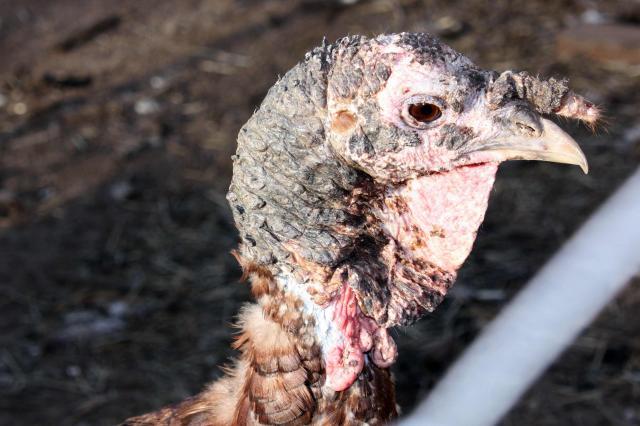Hi everyone, I'm new at posting here, but am not new at hanging around BYC and reading other peoples' posts. I already posted this question at the emergencies/diseases topic, but the discussion went kind of dead there. I didn't want to annoy the people there by bumping my own question up to the top, so I figured I'd ask the turkey experts here.
The short story is: we came home from a week on the road and found one of our Bourbon Reds with a very sad case of something very black, leathery and yucky on his head. It looks like this:

He is a little lethargic/dazed, but he's getting around OK, and the other birds aren't picking on him. On the thread I started on the emergencies/diseases page, it was suggested that he might have fowlpox. From my web research, that seems plausible, but this guy's head seems so much worse than any of the photos I can find online. The only photographic examples I can find show individual black dots, not a big leathery scab covering his whole head.
So, I'm just looking for confirmation/second opinion. Fowlpox or turkeypox? Or something else?
Thanks for taking a look and offering your thoughts. Now that I've overcome my shyness of posting here, I bet I'll have lots to say in the future!
The short story is: we came home from a week on the road and found one of our Bourbon Reds with a very sad case of something very black, leathery and yucky on his head. It looks like this:

He is a little lethargic/dazed, but he's getting around OK, and the other birds aren't picking on him. On the thread I started on the emergencies/diseases page, it was suggested that he might have fowlpox. From my web research, that seems plausible, but this guy's head seems so much worse than any of the photos I can find online. The only photographic examples I can find show individual black dots, not a big leathery scab covering his whole head.
So, I'm just looking for confirmation/second opinion. Fowlpox or turkeypox? Or something else?
Thanks for taking a look and offering your thoughts. Now that I've overcome my shyness of posting here, I bet I'll have lots to say in the future!

